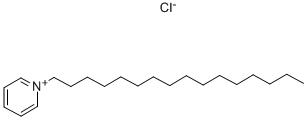CetylpyridiniumChloride , 10mMinDMSO , 123-03-5
Synonym(s):
1-Hexadecylpyridinium chloride;Cetylpyridinium chloride monohydrate;Hexadecylpyridinium chloride monohydrate
CAS NO.:123-03-5
Empirical Formula: C21H38ClN
Molecular Weight: 339.99
MDL number: MFCD00011731
EINECS: 204-593-9
| Pack Size | Price | Stock | Quantity |
| 1ml | RMB239.20 | In Stock |
|
| others | Enquire |
PRODUCT Properties
| Melting point: | 77°C |
| Boiling point: | 496.25°C (rough estimate) |
| Density | 0.9362 (rough estimate) |
| vapor pressure | 0Pa at 25℃ |
| refractive index | 1.6000 (estimate) |
| storage temp. | Inert atmosphere,Room Temperature |
| solubility | Freely soluble in water; very soluble in chloroform;
very slightly soluble in ether; insoluble in acetone, acetic acid,
and ethanol. |
| form | White Crystalline Powder |
| color | White to off-white |
| Odor | at 100.00?%. pyridine |
| Water Solubility | 111g/L at 20℃ |
| Stability: | Stable. Combustible. Incompatible with strong oxidizing agents, strong bases. |
| LogP | 1.71 at 20℃ |
| CAS DataBase Reference | 123-03-5(CAS DataBase Reference) |
| EPA Substance Registry System | Cetylpyridinium chloride (123-03-5) |
Description and Uses
Cetylpyridinium is a quaternary ammonium with broad-spectrum antiseptic activities. It is active against S. mutans, S. sanguis, E. coli, Oxford Staphylococcus, and C. albicans in media (MICs = 1.25-62.5 μg/ml) and against Oxford Staphylococcus in pooled human saliva (MICs = 7.8-15.6 μg/ml). Cetylpyridinium slows plaque formation for at least 21 days compared to a deionized water control in a rat incisor plaque model when applied topically at concentrations ranging from 0.025 to 2%. Formulations containing cetylpyridinium have been used as antiseptic agents in the treatment of gingivitis and as antimicrobial agents in raw food processing.
Antibacterial in cough lozenges and syrups; emulsifier.
Safety
| Symbol(GHS) |   GHS06,GHS09 |
| Signal word | Danger |
| Hazard statements | H301-H315-H319-H330-H335-H400-H410 |
| Precautionary statements | P260-P271-P280 |
| RIDADR | 2811 |
| HazardClass | 6.1(b) |
| PackingGroup | III |
| HS Code | 2933399990 |
| Hazardous Substances Data | 123-03-5(Hazardous Substances Data) |


